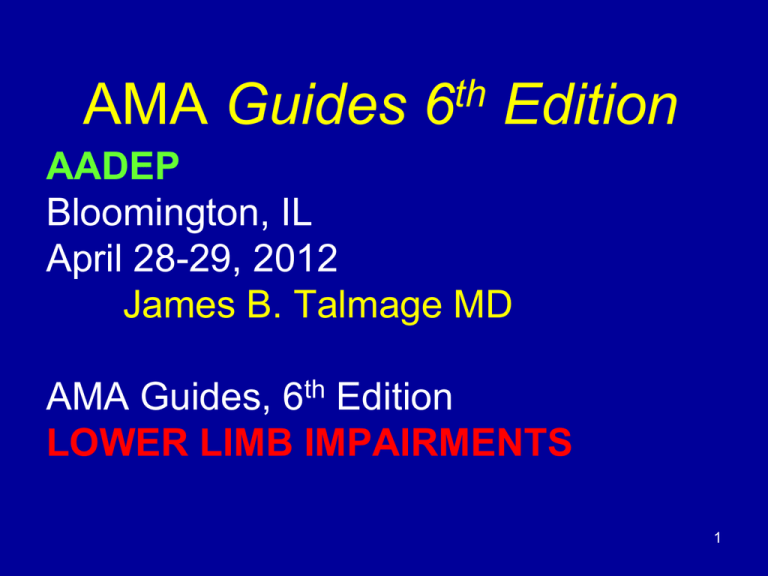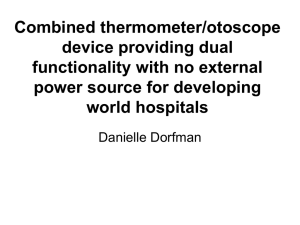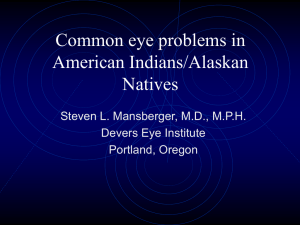AMA Guides: Lower Limb Impairment Assessment
advertisement

AMA Guides th 6 Edition AADEP Bloomington, IL April 28-29, 2012 James B. Talmage MD AMA Guides, 6th Edition LOWER LIMB IMPAIRMENTS 1 Questions ? James B. Talmage MD, Occupational Health Center, 315 N. Washington Ave, Suite 165 Cookeville, TN 38501 Phone 931-526-1604 (Fax 526-7378) olddrt@frontiernet.net olddrt@occhealth.md 2 2 ICF Model of Impairment Key to the AMA Guides 6th Edition Pathology Impairment DISABILITY HANDICAP 3 3 AMA Guides, 6th Edition CHAPTER 16 The Lower Extremities 4 Chapter 16: Lower Extremities 16.1 Principles of Assessment pg 494 16.2 Diagnosis-Based Impairment pg 497 Used 16.3 Adjustment Grid and Grade Modifiers MOST – Non-Key Factors pg 515 often 16.4 Peripheral Nerve Impairment pg 531 16.5 Complex Regional Pain Syndrome Impairment pg 538 16.6 Amputation Impairment pg 542 16.7 Range-of-Motion Impairment pg 543 16.8 Summary pg 552 16.9 Appendix 16-A Lower Limb Questionnaire pg 555 5 Lower Extremity • Similar in Philosophy and Methodology to the Upper Extremity and Spine. • Most conditions will be rated by Diagnosis from the Diagnosis Based Grids. • Many “rules” copied and pasted from the Upper Extremity chapter. 6 Assigning Impairment p 500 • “Range of motion will, in some cases, serve as an alternative approach to rating impairment. It is NOT combined with the diagnosis-based impairment, and stands alone as an impairment rating.” • Compared to Upper Extremity, – ROM will be used very little. 7 Assessing Lower Limb Musculoskeletal Impairment • 6th Edition emphasizes the impact of the impairment on ADLs at MMI. • The most accurate DIAGNOSIS is the foundation of the impairment – Diagnosis-Based Impairment (DBI). • - p 495 “The authors of this chapter recognize that the process described is still far from perfect with respect to defining impairment … however, the author’s intention is to simplify the rating process, to improve interrater reliability, and to provide a solid basis for future editions of the Guides.” – p 494 8 Lower Extremity: Divided into 3 Regions • Foot and Ankle – Midshaft tibia to tips of toes. • Knee – Midshaft femur to midshaft tibia • Hip – From articular cartilage of the acetabulum to midshaft of the femur. Note 1: Pelvis ratings are found in Chapter 17.4, p. 592-97 (SPINE Chapter) Note 2: Vascular Diseases affecting the Lower Extremities found in Chapter 4.8 Note 3: LE%= 0.4% WPI 9 10 Page 530-531 11 Page 499 Steps in Determining Impairment. 12 Lower Extremity: DBI (p 495) STEP ONE (DIAGNOSIS) • Choose the most accurate Regional DIAGNOSIS • Impairment class is determined by the diagnosis and specific criteria, considered the KEY FACTOR, and then adjusted by GRADE MODIFIERS or non-key factors. • List all diagnoses for each region. • In the event a specific diagnosis is not in the DiagnosisBased Grid, use the closest similar condition listed as a guide to determining the Diagnosis portion of the Impairment , and explain your rationale. “RIGHT TABLE, RIGHT ROW” 13 LE Algorithm to Final DBI % - STEP ONE (DIAGNOSIS) • THREE REGIONAL GRIDS, lists all possible diagnoses within each LE region (foot/ankle, knee, and hip). Table 16-2; p 501-8 Table 16-3; p 509-11 Table 16-4; p 512-15 14 LE Algorithm to Final DBI % Step One: Diagnostic Criteria Grid One FOOT/ANKLE REGION (Table 16.2, p501-8) • Soft Tissue: Typically assigned the lowest impairments – Nail abnormalities secondary to trauma – Callus/recurrent healed plantar ulceration under post traumatic bony prominence; contusion/crush injury; plantar fasciitis; plantar fibromatosis; symptomatic soft tissue mass (ganglion, 15 etc); retrocalcaneal bursitis. LE Algorithm to Final DBI % Step One: Diagnostic Criteria FOOT/ANKLE REGION • Muscle/Tendon: – Strain; tendonitis; or herniated or ruptured tendon, specifically involving posterior tibial, anterior tibial, Achilles, or peroneal tendon (all other tendons below) – Strain; tendonitis; or herniated or ruptured tendon – All other tendons 16 LE Algorithm to Final DBI % Step One: Diagnostic Criteria FOOT/ANKLE REGION • Ligament: (Ligament/Bone/Joint given highest impairment %) – Joint instability/ligamentous laxity-traumatic – Ankle (including syndesmosis)[reference table 16-8] – Joint instability/ligamentous laxity-traumatic; metatarsalphalangeal [MTP]. 17 LE Algorithm to Final DBI % Step One: Diagnostic Criteria FOOT/ANKLE REGION • Fracture/Dislocation: – Tibia(extra-articular); tibia(intra-articular – pilon/plafond); Ankle (malleolar, bimalleolar, trimalleolar); Talus; Calcaneus; Navicular/cuboid(transtarsal)/charcot; Metatarsaltarsal fracture/dislocation; metatarsal(s); sesamoid; phalanx. 18 LE Algorithm to Final DBI % Step One: Diagnostic Criteria FOOT/ANKLE REGION • Deformity: – Midfoot-cavus; midfoot-”rocker bottom” • Arthritis: – Degenerative condition: unrelated and symmetric; pan-talar (tibial-talar, talar-calcaneal, talarnavicular) – Ankle; Subtalar; talonavicular; calcaneocuboid; first metatarsophalangeal joint; other metatarsophalangeal joint; interphalangeal joints 19 LE Algorithm to Final DBI % Step One: Diagnostic Criteria FOOT/ANKLE REGION • Athrodesis (Joint Ankylosis, fusion): – Pan-talar; tibial to calcaneal fusion; ankle; subtalar; double or triple arthrodesis; toes; total ankle replacement 20 Foot and Ankle • 8 Pages of Diagnoses 21 LE Algorithm to Final DBI % Step One: Diagnostic Based Criteria Grid Two KNEE REGION (Table 16-3, p509-11) • Soft Tissue: – Bursitis, plica, h/o contusion, or other soft tissue lesion • Muscle/Tendon: – Strain; tendonitis; or ruptured tendon – Myositis ossificans (hypertrophic ossification) 22 LE Algorithm to Final DBI % Step One: Diagnostic Criteria KNEE REGION • Ligament/Bone/Joint: – Meniscal injury; cruciate or collateral ligament injury – surgery not rating factor; cruciate and collateral ligament injury – surgery not rating factor. • Patellar Lesion: – Patellar subluxation or dislocation – Patellectomy 23 LE Algorithm to Final DBI % Step One: Diagnostic Criteria KNEE REGION • Fracture: – Femoral shaft fracture; supracondylar or intercondylar fracture; patellar fracture; tibial plateau fracture; proximal tibial shaft fracture • Arthritis: – Primary knee joint arthritis; patellofemoral arthritis • Arthrodesis: – Arthrodesis (joint ankylosis, fusion) • Osteotomy/Knee Replacement: – s/p tibial osteotomy; total knee replacement 24 25 Knee • 3 Pages 26 Knee Foot and Ankle Grids: (501-508) 8 pages Knee Grids: (509-511) Only 3 pages Hip Grids: (512-515) 3 ½ pages 27 LE Algorithm to Final DBI % Step One: Diagnostic Criteria Grid Three HIP REGION Table 16-4, p512-515 • Soft Tissue: – Bursitis, h/o contusion, or other soft tissue lesion • Muscle/Tendon: – Strain; tendonitis; or h/o ruptured tendon – Myositis ossificans (hypertrophic ossification) 28 LE Algorithm to Final DBI % Step One: Diagnostic Criteria HIP REGION • Ligament/Bone/Joint: – Hip dislocation; avascular necrosis; acetabular labral tear • Fracture: – Osteochondral fracture; osteochondritis dissecans; fractures about the hip joint (acetabulum and proximal femur) • Arthritis: – Degenerative conditions; hip arthritis (arthosis) 29 LE Algorithm to Final DBI % Step One: Diagnostic Criteria HIP REGION • Arthrodesis: – Hip joint arthrodesis (ankylosis, fusion) • Osteotomy/Joint Replacement: – s/p Femoral osteotomy; total hip replacement 30 STEP TWO (place the diagnosis in a CLASS) • THREE REGIONAL GRIDS, list all possible diagnoses within each LE region – Foot/ankle – Knee – Hip 31 LE Algorithm to Final DBI % - STEP TWO (CLASS) Table 16-1 Definition of Impairment Classes (pg. 495) Class Problem Lower Extremity (LEI) Whole Person (WPI) 0 No objective findings 0% 0% 1 Mild 1%-13% LEI 1%-5% WPI 2 Moderate 14%-25% LEI 6%-10% WPI 3 Severe 26%-49% LEI 11%-19% WPI 4 Very Severe 50%-100% LEI 20%-40% WPI 32 Example: Total Hip 21 23 25 25 25 Errata 3 possible classes for THR 2 sets of numbers in Class 4 33 LE Algorithm to Final DBI % - STEP TWO (CLASS) CONTRADICTION • REPEAT process for EACH separate DIAGNOSIS in each limb involved. • In most cases only ONE DIAGNOSIS will be appropriate. (1 per grid) – MAY rate both an ankle and a hip fracture. • If a patient has 2 significant diagnoses (i.e. ankle instability and posterior tibial tendonitis) use the (one) diagnosis with the highest impairment rating for the impairment calculation. - p 497 34 LE Algorithm to Final DBI % - STEP TWO (CLASS) CONTRADICTION • REPEAT process for EACH separate DIAGNOSIS in each limb involved. • In most cases only ONE DIAGNOSIS will be appropriate. • “If more than 1 diagnosis can be used, the 1 that provides the most CLINICALLY ACCURATE impairment rating should be used; this will generally be the more specific diagnosis. Typically 1 diagnosis will characterize the impairment and its impact on ADLs.” - p 499 35 ERRATA 36 Example 16-9 p 526 • Subject: 52 year old man • History: Twisting injury –s/p ACL reconstruction and medial meniscal repair 37 Example 16-9 p 526 38 Example 16-9 p 526 "The methodology requires the examiner to pick one diagnosis for the region. The anterior instability diagnosis was chosen, and the effect of the meniscal tear is reflected in the adjustments." • INCREASE the Clinical Studies Grade Modifier to reflect the ADDITIONAL PATHOLOGY present 39 Example 16-9 p 526 • Clinical Studies: Current weight-bearing X rays show bioabsorbable fixation of the ACL in good position with a normal 5 mm joint space in all 3 compartments. 40 Example 16-9 • "Diagnosis: "cruciate or collateral ligament injury" with mild instability assigned to class 1 with a default value of 10% LEI. • Functional History judged unreliable in the presence of only mild instability and no atrophy, and thus not used in rating. • Physical exam instability not used as a grade modifier since stability was used in class assignment. No atrophy would be grade 0, but 5° flexion contracture would be rated at 10% LEI by table 1623, and table 16-25 indicates a 10% LEI rating would be a mild degree of problem, or a grade 1 modifier from table 16-7. 41 Example 16-9 • Clinical Studies: The anterior cruciate reconstruction in good position without joint space narrowing on current weight bearing xrays by itself would be a grade 1, mild pathology adjustment. The presence of the meniscal tear and subsequent repair (documented in the operation report) would justify moving up a grade to grade 2 for the final clinical studies adjustment. • The net adjustment is +1, so class 1, grade D, or 12% LEI is the final rating." 42 Example 16-9 p 526 • Diagnosis: ACL “mild laxity” – Class 1 • Diagnosis: Meniscal injury – Class 1 • FH = grade 4, but not utilized [INVALID] • PE = grade 1 Flexion contracture • CS = grade 1 2 – [Move up because of meniscal tear/repair] • Net Adjustment = + 1, and grade D is used for ACL. Class1, Grade D = 12% LEI 43 Example 16-9 • Final rating for ACL reconstruction AND medial meniscal tear with repair is from CLASS One, Grade D 44 LE Algorithm to Final DBI % - STEP TWO (CLASS) • “Subjective complaints without objective physical findings or significant PE abnormalities are typically assigned class 0 with no ratable impairment.” - p 497 • “Objective findings are always given the greater weight of evidence over subjective complaints” – p 495 • “If an examiner is routinely using multiple diagnoses without objective supporting data, the validity and reliability of the evaluation may be questioned.” - p 497 45 Pick the CLASS • Some Diagnoses have more than one Class, and the words (text) within the table direct you to the PROPER CLASS 46 LE Algorithm to Final DBI % - STEP THREE (GRADE) • DBI is defined by CLASS & GRADE. • Once the Impairment (severity) Class (IC) and the GRADE (0-4) is determined, a GRADE MODIFIER (A, B, C, D, E) is initially assigned the DEFAULT VALUE = C. 47 STEP THREE (GRADE) • The final impairment grade, within the class is calculated using Grade modifiers, or non-key factors (Section 16.3) - p 497 • Non-key Grade modifiers are determined from: – Functional History (FH) – Physical Examination (PE) – Clinical Studies (CS) • NON-key Grade modifiers are considered only if they are reliable and associated with the DIAGNOSIS. – p 495 • NON-key “Grade modifiers allow movement within a class, but DO NOT ALLOW MOVEMENT INTO A DIFFERENT CLASS.” - p 497 48 Diagnosed-Based Impairments and Adjustment Factors Diagnostic Class 0 Criteria RANGES 0% GRADE Class 1 Class 2 Class 3 Class 4 1% - 13% 14%-25% 26%-49% 50%-100% ABCDE ABCDE ABCDE ABCDE # # # ## # # # ## # # # ## # # # ## Default Default Default Default Grade Modifier 4 Very Severe Problem Very Severe Problem Very Severe Problem Adjustments Non-Key Factor Non-Key Factor Functional History Grade Modifier 0 No Problem Grade Modifier 1 Mild Problem Grade Grade Modifier Modifier 2 3 Moderate Severe Problem 1-2= minus 1Problem Physical Exam No Problem Mild Problem Moderate Severe Problem 1-2= minus 1Problem Clinical Studies No Problem Mild Problem Moderate Severe Problem 1-2= minus 1Problem 49 Net Adjustment Formula Adjustment -2 -1 0 1 2 Grade A B C D E Modifiers permit moving Up or Down within a Class to a different severity Grade. Modifiers do NOT permit changing to a different Class. 50 50 Functional History p 496 • “Functional (History) assessment is only considered for the limb impairment with the highest rating, since it is expected that this will encompass the functional limitations related to other impairments in the same limb.” – Also on page 516 51 Functional History: Page 516 Watching a limp Is part of the Physical Exam, NOT part of the History. 52 LE Algorithm to Final DBI % - STEP THREE (GRADE) Non-Key Grade Modifiers • Functional History (FH): -p 496 – Grade modifier 0: no demonstrable interference with function – Grade modifier 1: interference with the vigorous or extreme use of the limb only. – "Grade modifier 2: antalgic limp that limits ambulation distance; regularly uses orthotic device (at least ankle-foot orthosis) – Grade modifier 3: antalgic limp; routine use of 2 canes, or 2 crutches, or knee-ankle-foot orthosis – Grade modifier 4: non-ambulatory 53 Functional History p 496 • “A functional assessment tool MAY be used … to further evaluate this parameter. The physician is expected to weigh the patient’s subjective complaints and SCORE on the … tool, relative to the expected severity for a given condition. The grade MODIFIER that reflects this analysis MAY be accepted OR NOT as a variable in the impairment calculation.” 54 Functional History p 516 • “If the grade for Functional History differs by 2 or more grades from that defined by physical examination or clinical studies, the Functional History SHOULD be assumed to be unreliable. • If … unreliable or inconsistent with the other documentation, it is EXCLUDED from the grading process.” – Note: “or”, Does not say from the higher of either the PE or the CS 55 Function Adjustment: Lower Limb Note: Watching a patient’s gait is part of the Physical Exam, NOT part of the History. NO numbers in this table to define what a score means. 56 56 Functional History page 516 AAOS Lower Limb Instrument “… may be used… “ “… only to assist …” “… does not serve as a basis for defining further impairment …” “… assess the reliability of the functional reports recognizing the potential influence of behavioral and psychological factors.” If the grade for functional history differs by 2 or more grades from that defined by physical examination or clinical studies the functional history should be assumed to be unreliable.” 57 57 AAOS Outcome Instrument 58 58 Questions re-written for legibility AAOS Lower Limb Outcome Score 1. During the past week, how stiff was your lower limb? 2. During the past week, how swollen was your lower limb? During the past week, how painful was your lower limb during: 3. Walking on flat surfaces? 4. Going up or down stairs? 5. Lying in bed at night? 59 59 Questions re-written for legibility AAOS Lower Limb Outcome Score 6. Which of the following statements best describes your ability to get around most of the time during the past week? 7. How difficult was it for you to put on or take off your socks/shoes during the past week? 60 60 http://www.aaos.org/research/outcomes/Lower_LimbScoring.xls Calculation of Standardized & Normative Scores: The Standardized and Normative Scores will only be calculated for the first 500 records. They are on the third tab of this worksheet. Standardized score: 0-100 Normalized score MINUS 16 TO PLUS 57 Missing Items: If an item contained within a scale is not answered, that item is not computed into the mean used for that scale. Standardized scores and Normative Scores should be rounded to the nearest whole number. Standardized scores are calculated so that a "0" represents a poor outcome/worse health while "100" is the best possible outcome/best health. Normative scores are calculated so that a higher scores indicate better functioning. All scores are referenced to the general/healthy population Normative mean score of 50. NOTE: There are 2 different methods that could be used to score this. For more information on Normative Scores, please see the "Outcomes - Understanding Scoring, Normative Study, Reliability & Validity" webpage. Answers of 'cannot do activity due to other reason' for Questions 3 through 5: a choice of "7" on these items is considered to be missing and recoded automatically in the worksheet. Standardized Mean and Normative Scores should only be generated if a respondent answered at least 4 items. Note that this rule includes items which are considered missing due to recoding of 'cannot do activity due to other reason' (as noted above). 61 61 http://www.aaos.org/research/outcomes/Lower_LimbScoring.xls The algorithm for the lower limb core scale is as follows: component value Result a= (Q1 -1)* 5/4 Value ranging 0 to 5 b= (Q2 -1)*5/4 Value ranging 0 to 5 c= (Q3 - 1) if rated 1-6; a rating of 7 (could not do for other reason) is considered missing Value ranging 0 to 5 d= (Q4 - 1) if rated 1-6; a rating of 7 (could not do for other reason) is considered missing Value ranging 0 to 5 e= (Q5 - 1) if rated 1-6; a rating of 7 (could not do for other reason) is considered missing Value ranging 0 to 5 f= (Q6 - 1)*5/6 Value ranging 0 to 5 g= (Q7 - 1) Value ranging 0 to 5 Output on Standardized & Normative Score Worksheet Result Raw score: (sum of all components a through g) Value ranging 0 to 35 Mean of Items: (sum of all components a through g) / (number of non-missing items) Value ranging 0 to 5 Standardized Mean*: 100 - 100 x (mean of items)/5 Value ranging 0 to 100 Normative Score: 10 * [ (Standardized mean score - General population score) / General population standard deviation ] + 50. Value ranging -16 to 57 * For all 0-100 scales, a "0" represents a poor outcome and a "100" represents the best possible outcome. Unhide rows 2-3 and all columns on the "Standardized & Normative Scores" Worksheet for more information on recoding procedures. 62 62 No Method to convert score (number) to Words (like “moderate”) ERRATA PROVIDES NO GUIDANCE Chapter 16 has 19 examples: NONE even mention the AAOS Lower Limb Instrument 63 63 LE Algorithm to Final DBI % - STEP THREE (GRADE) •Physical Examination (PE): Page 496 •Document LE objective findings: gait, limb length discrepancy, deformity, MMT, atrophy, instability, ROM deficits and neuro findings (sensory/motor/DTR deficits). •Remove braces, orthotics, etc., if appropriate •Document quantitative POSITIVE, NEGATIVE, & nonphysiological findings bilaterally. Use opposite extremity if uninvolved TO DEFINE NORMAL. Use quantitative findings - Avoid general descriptions. 64 65 Physical Examination • “Examination findings that differ significantly from previously recorded observations AFTER the probable date of MMI should be reported, with comments noting the discrepancy; these findings MAY BE EXCLUDED from the impairment calculation.” – p 496 66 Physical Examination • “If physical examination findings are determined to be UNRELIABLE or INCONSISTENT, or they are for conditions unrelated to the condition being rated, they are EXCLUDED from the grading process. The physician must explain, in the report, the rationale for the choice of grade.” - p 517 67 Physical Exam • “If the neurologic exam points to an underlying spine disorder, the lower extremity (impairment) would, in most cases, be accounted for in the spine impairment rating, assuming there are no other primary lower extremity diagnoses requiring a concomitant rating.” - p 496 68 Physical Exam: Range of Motion • “Range of motion is graded according to the process and the criteria specified in Section 16.7.” • “If it is clear to the evaluator that a restricted range of motion has an organic basis, 3 measurements should be obtained and the GREATEST range measured should be used …” – p 517 69 Physical Exam: Range of Motion • “If multiple previous evaluations have been documented, and there is inconsistency in a rating class [as in ONE CLASS] between the findings of 2 observers, or in the findings on separate occasions by the same observer, the results are considered INVALID.” - p 518 70 Physical Exam: Range of Motion • “Range of motion restrictions in multiple directions DO INCREASE the impairment.” – ADD impairments for all 6 directions of hip movement. • “Range of motion impairment is NOT combined with the diagnosis-based impairment.” - p 518 71 Physical Exam: ATROPHY • “For muscle atrophy, the limb circumference should be measured and compared to the OPPOSITE limb at equal distances from either the joint line or another palpable anatomic structure. For example, thigh circumference may be measured 10 cm above the patella and compared (to) a similar measure on the other leg.” [thigh] - p 518 72 Physical Exam: ATROPHY • “Calf circumference is compared at the level of maximal circumstance bilaterally. • Neither limb should have swelling or varicosities that would invalidate the measurements.” - p 518 73 Physical Exam: p 518 Limb Length Discrepancy • Measure with a tape measure ASIS to medial malleolus bilaterally. • Measure 3 times and average “… to reduce measurement error.” • “Skeletal … teleroentgenography is recommended.” 74 75 76 LE Algorithm to Final DBI % - STEP THREE (GRADE) Non-Key Grade Modifiers • Clinical Studies (CS): p 496 • “While imaging and other studies may assist physicians in making a Diagnosis, they are NOT the sole determinants of a Diagnosis. • “Clinical test results that do not correlate with the patient’s symptoms or support the diagnosis should not be mentioned.” – [considered in the final DBI = 0%] 77 Clinical Studies • “In some cases, the class will be defined by physical examination findings or clinical studies results. When this is the case, those findings MAY NOT BE USED to determine the grade in the correlating adjustments grid.” -p 500 • “If physical findings have been used to determine class placement, they should NOT be considered again, for example, range of motion in many lower extremity diagnoses.” - p 517 78 Clinical Studies • "For adjustment purposes findings at maximal medical improvement are used." –I.E. DO NOT use x-ray on day on injury, rather use the final x-ray for rating. 79 Clinical Studies: Imaging P 519-520 No definitions for “mild”, “moderate”, “severe”, & “very severe”. NO definition for “CONFIRM PATHOLOGY”. 80 Clinical Studies p 518 • Arthritis is graded by cartilage interval on STANDING (Weight bearing) x-rays. • Ideal camera-to-film distance is 90 cm (36 inches). – Ankle: mortise view – Knee: standing A-P view • Flexion contracture precludes evaluation – Patellofemoral joint: “sunrise” view – Hip: standing A-P view 81 P 519-520 82 BILATERAL ? No Guidance Perhaps 5th Ed T17-31, p 544 83 ERRATA 84 NOTE: 5TH Ed. • If alternate method needed. Grade 1 Grade 2 Grade 3 Grade 4 85 Clinical Studies page 520 • NO Definitions in EITHER book or Errata • Consult EMG Text or MD doing the EMG 86 Class 4 EXCEPTION P 521-522 • “If the key factor is class 4, and both non-key factors were grade modifier 4, the difference would summate to zero, and placement in a grade above the default value C in class 4 would not be possible. In order to correct this deficiency, if the key factor is class 4, automatically add +1 to the value of each non-key factor.” 87 Class 4 EXCEPTION P 521-522 • “For example, – if the key factor is class 4, – and the first non-key factor was grade 3, – the second was grade 4, – the differences are -1 and zero, or -1. • Adding +1 to each of these yields zero and +1; – this summates to +1. • Consequently, the final class (is) 4 and the final impairment is class 4 grade D.” 88 16.4 Peripheral Nerve Impairment • Peripheral nerve impairment may be combined with DBI’s, if the DBI does NOT already include the nerve impairment. – p 531 • Impairment due to chronic pain is discussed in Chapter 3, Pain. - p 531 • Motivation and behavioral concerns are considered in Chapter 14, Mental and Behavioral Disorders. - p 531 • This section is NOT used for nerve entrapments, since nerve entrapments are not isolated traumatic events.” - p 533 – HOWEVER, There is NO section for Nerve Entrapment in the Lower Limb Chapter 89 Peripheral Nerve Impairment • “Characteristic deformities and manifestations resulting from peripheral nerve lesions, such as restricted motion, atrophy, and vasomotor, trophic, and reflex changes, have [already] been taken into consideration in the impairment values shown in this section.” – p 531 • “Therefore, when impairment results strictly from a peripheral nerve injury, no other rating method is applied to this section to avoid duplication or unwarranted increase in the impairment.” – p 531 90 P 537 91 P 537 92 Page 532: Sensory Exam • "The examiner's finger tip, or a cotton tipped applicator can be used to assess light touch. • Sharp dull recognition and protective sensation can be assessed using a disposable pin. • The sensory exam results should conform to the cutaneous distribution of a peripheral nerve, or a branch of a peripheral nerve.” 93 • "The sensory exam should be classified into one of five categories. Severity grade 0 is Normal sensibility and sensation. • Severity grade 1 is subjectively altered sensory perception but retained light touch and sharp dull recognition. In this grade the examinee correctly reports each time he/she is touched, but stimuli are perceived as subjectively abnormal (paresthesia-like), but in only the distribution of a particular cutaneous nerve. • Severity grade 2 is impaired light touch, but retained sharp dull recognition. This means several of the light touch stimuli are not felt by the examinee, but sharp and dull stimuli are consistently recognized correctly. • Severity grade 3 is impaired sharp dull recognition, but retained protective sensibility. In this grade light touch recognition is severely impaired, and sharp dull discrimination is absent, but the sharp side of the pin is recognized as touching the examinee, and protective sensation is still present, as recognized by the absence of blisters, burns, abrasions, scars, etc from unrecognized trauma or repetitive activity. • Severity grade 4 sensation is absent sensation and no protective sensibility. There should be no recognition of light touch and no recognition of touch with the sharp side of the pin, and there will usually be signs of skin injury (blisters, scars, burns, abrasions, etc.). • ERRATA 94 Page 532: Sensory Exam • "If nerve conduction testing has been done, there should be at least major sensory conduction block if the physical exam is consistent with sensory severity grade 3, and • there should be axon loss or no recordable sensory nerve action potential (SNAP) if the physical exam is consistent with sensory grade 4 severity." 95 W Lynch, et al • Most common definition of normal monofilament testing on the foot is in the diabetic neuropathy literature and accepts 4.17 gm as normal and 5.07 gm as abnormal. • J AM Podiatr Med Assoc: 1999; 89 (8): 383-391 – “A Model to Assess Age-Related Changes in TwoPoint Discrimination of Plantar Skin.” – 2 point decreases linearly with age. – Normal on the toes and plantar foot varies from 10-30 mm 96 THE Homunculus Big Hand Little Foot 97 Peripheral Nerve Impairment • Motor strength evaluation: –“Muscle strength testing is voluntary in that it requires full individual concentration and cooperation.” - p 533 –“Muscle atrophy, although not rated separately, can be a more objective sign of motor dysfunction.” - p 533 98 Peripheral Nerve Impairment • Motor strength evaluation: – “To be valid, the results should be concordant with other observable pathologic signs and medical evidence.” p 533 – “If the measurements are made by 1 examiner, they should be consistent on different occasions. – If made by 2, they should be consistent between examiners.” p 533 99 Peripheral Nerve Impairment • “If findings vary by more than 1 grade between observers or by the same observer on separate occasions, the measurements should be considered invalid.” - p 533 100 P 534-536 Motor OR SENSORY 101 ERRATA 102 30, not 50 Errata: Delete “mild” 103 CRPS: p 538-542 • “… challenging and controversial concept.” • “… epidemiologic studies indicating that most such diagnoses are made within a workers’ compensation context.” • “Since a subjective complaint of pain is the hallmark of this diagnosis, and since all of the associated physical signs and radiologic findings can be the result of disuse, an extensive differential diagnostic process is necessary.” p 538 104 CRPS p 538-542 • Differential diagnoses …must be ruled out include disuse atrophy, unrecognized general medical problems, somatoform disorders, factitious disorder, and malingering. A diagnosis of CRPS may be excluded in the presence of any of these conditions, or any other conditions which could account for the presentation.” p 539 105 CRPS • A diagnosis of CRPS may be excluded in the presence of any of these conditions • Exclusion is necessary due to the general lack of scientific validity of the concept of CRPS and its extreme rarity. Any of the differentials would be far more probable (pg 541) 106 CRPS • Diagnosis of CRPS has not been validated scientifically as representing a specific and discrete health condition • Diagnostic process is unreliable as competing diagnostic protocols and definitions are continuously being introduced and utilized 107 CRPS • “No gold standard which reliably distinguishes the diagnosis of CRPS from presentations which clearly are not CRPS” • “a diagnosis of CRPS may create a dilemma for an evaluator” • “Scientific findings have actually indicated that whenever this diagnosis is made, it is probably incorrect” (pg 539) 108 CRPS: • CRPS Type 1: (old term was RSD) – Rated by section 16.5 CRPS and impairment is based on Table 16-15. • CRPS Type2: (old term was causalgia) – “In CRPS II a specific sensory or mixed nerve structure is involved; therefore, the rating is based on Table 16-12 (Peripheral Nerve Impairment… With CRPS II the severity is first determined using Table 16-14 (Objective criteria)” page 540 – Class assignment is from Table 16-14. 109 Diagnostic criteria • IASP criteria do not appear in 6th, although referenced. • “Budapest criteria”…modification of IASP to improve specificity, decrease sensitivity. Not approved by any certifying body to date. – PAGE 539 table 16-13; 110 Must meet Criteria for CRPS Diagnosis Page 539 111 Table 16-13: p 539 • At least 1 symptom in 3 of the 4 categories: – Sensory: allodynia • “If you touch my leg, it hurts.” – Vasomotor: skin color or temperature change • “My leg turns blue.” – Sudomotor/edema: • “My leg swells.” – Motor/Trophic: • “My leg is weak.” 112 Table 16-13: p 539 • At least 1 sign in ≥ 2 of the 4 categories: – Sensory: allodynia, exagerated tenderness – Vasomotor: Temp or color change – Sudomotor/Edema: edema or sweating – Motor/Trophic: decreased ROM or weakness, tremor, dystonia, and/or trophic changes (hair, nail, skin). 113 Rating CRPS: After the Diagnosis is “Established” • Determine if it is a ratable diagnosis. – Table 16-13, p 539 • Count up the number of objective signs – Table 16-14, p 540 (sings or “points”) CRPS class # of Points required Class 0 0-3 Class 1 4-5 Class 2 6-7 Class 3 ≥8 Class 4 ≥8 114 P 540 COUNT Objective Findings 115 P 541 116 Rating CRPS • Different from other diagnosis based impairments. • “The rating for CRPS is a “stand alone” approach. If impairment is assigned for CRPS, no additional impairment is assigned for pain from Chapter 3, NOR is the CRPS impairment combined with ANY OTHER approach for the same extremity from this chapter.” p 540 117 Rating CRPS • Different from other diagnosis based impairments. • “AVERAGE the grade modifier numbers and use this information to define the class number in Table 16-15. • If that class number is not supported by the objective diagnostic criteria points, then the highest class specified by those points is selected ...” p 540 118 Rating CRPS • Different from other diagnosis based impairments. • “Using CLINICAL JUDGMENT, select the appropriate grade within the class. Since the adjustment factors are used to define the class they cannot be used to determine the grade within the class.” • “… decrease or increase the grade within the assigned class and must explain in detail the rationale for any adjustments.” p 540 119 P 541 120 Amputation • • • • • Section 16.6, page 542 Up to 40% WPI to include entire LE Table16-16, p. 542. unless proximal problems are ratable. Adjust for FH, PE, & CS Amputation impairment % may be combined with – – – – proximal DBI %, or proximal ROM %, creating an increased grade assignment, BUT EXPLAIN the RATIONALE FOR COMBINING! P.542. 121 Amputation: Clarification • “Amputation impairment is based on the level of the amputation with adjustments for proximal problems reflected by functional history, physical examination and clinical studies.” -p 542 • “The amputation impairment may be combined with proximal diagnosed-based impairments or proximal range of motion impairments; the examiner must explain the rationale for combining.” –p542 • Proximal problems are rated by only 1 of these 2 methods. 122 Amputation: Clarification 123 Grade C is consistent with PPI% in prior editions Grade C is the minimum value. 124 Range of Motion, Section 16.7 • “Diagnosis-Based Impairment is the method of choice for calculating impairment. • Range of motion is used principally as a factor in the Adjustment Grid… • Some of the diagnosis based … grids refer to the range of motion section when that is the most appropriate mechanism for grading the impairment.” – p 543 125 Range of Motion, Section 16.7 • “This section is to be used as a STAND ALONE rating when other grids refer you to this section OR no other diagnosis based sections of this chapter are applicable for impairment rating of a condition.” – p 543 • Examples … include burns or other severe scarring causing permanent passive and active ROM losses, complex … or multiple tendon injuries, severe crush injuries, residual compartment syndromes, or other conditions not addressed in the regional grids, but having significant functional loss.” – p 543 126 Range of Motion, Section 16.7 • “There are additional exceptions when using ROM as the primary impairment is accepted.” – p 543 1. For amputation rating, deficits of ROM for the remaining portion of the limb…” 127 Range of Motion, Section 16.7 • “There are additional exceptions when using ROM as the primary impairment is accepted.” – p 543 – 2. In very rare cases, severe injuries may result in passive ROM losses qualifying for class 3 or 4 impairment. If the active ROM impairment percentage is greater than the percentage impairment derived from the diagnosis-based class, then the impairment is rated by ROM as a STAND ALONE rating. This ROM …impairment may only be used if the active ROM is within 10° of the passive ROM measured. The ACTIVE ROM is what determines the final impairment rating.” - 543 128 Physical Exam:Range of Motion • Instructions EARLIER in the chapter: • “If the opposite extremity is uninvolved, it should be used to define normal for that individual.” – p 496 • “Range of motion will, in some cases, serve as an alternative approach to rating impairment. It is not combined with the diagnosis-based impairment, and STANDS ALONE as an impairment rating.” – p 500 129 Physical Exam: Range of Motion • “If it is clear to the evaluator that a restricted range of motion has an organic basis, 3 measurements should be obtained and the GREATEST range measured should be used …” – p 517 • “Range of motion restrictions in multiple directions DO INCREASE the impairment.” 130 Range of Motion: Instructions • “Both extremities should be compared. If the contralateral joint is uninjured it may serve as defining normal for the individual.” – p 544 131 P 545 132 Error? P 546 • Text says patient should be seated on the examination table in front of the examiner, YET this figure shows what you would see with the patient prone and the knee flexed 90°. 133 Error ? p 546 • Text describes only 1 knee position for measurement, (90°) then says to average the readings. • 5th Edition, Fig 17-5 & 4th Edition Figure 56 (p 3/91) implied 2 measurements – Knee @ 0°, and 45° Page 517: Greatest of 3 measurements is used 3rd Edition, pages 55-56 and Figures 62-63 measurements were to be made with the Knee @ 0°, and 45° 134 Knee ROM p 546 • Note: – Flexion is actually gravity assisted flexion. – Extension is actually Passive extension. Note: Table 16-23 rates “Flexion Contracture”, not active extension (extension lag), and text on page 544 clearly differentiates between these 2 concepts 135 P 547 Pre-positioning Figure was mislabeled in prior Measuring right hip flexion editions. Measuring right hip flexion contracture 136 137 Hip Rotation p 548 EXTERNAL Rotation INTERNAL Rotation 138 P 551 Form suggests contralateral limb with mild age related loss of motion would have its “impairment” subtracted from that of the injured or involved limb. 139 P 544 ADDuction “The ranges listed in Tables 16-18 to 16-24 define the severity of impairment (mild, moderate, severe) …” USE the word, like “mild” to go to the diagnosis grid or the physical exam Grade Modifier 140 table Not in Errata “Add all impairment values at a joint.” –p 548 Footnote should apply to all ROM tables. Ignore the Comment on Knee deformity 5th Edition knee ROM table had Rows for knee deformity 141 ERRATA ADDuction 142 ROM Rating METHODOLOGY p 548 1. 2. Measure ROM From Tables 16-18 to 16-24 get impairment %s - If opposite limb’s joint is uninjured, adjust. 3. Add all impairments within a joint. - Combine impairments of separate joints. 4. Using Table 16-25 classify the severity - Derive a class. 5. If FH modifier exceeds the impairment class consider adjusting using Table 16-17 (p 545) for add on impairment. 143 Page 550 • This is ALL you need to translate a ROM impairment % (number) to a WORD (Class) 144 Range of Motion, Section 16.7 “The final impairment may be ADJUSTED for Functional History, in certain circumstances.”- p 543 “Adjustments for Functional History MAY be made if: 1. 2. 3. 4. The adjustment is a percentage ADD-ON to the total range of motion impairment…” 145 Range of Motion, Section 16.7 Adjustments for Functional History MAY be made if: 1. ROM is the only approach used in the extremity. 2. ROM measurements are reliable. 3. ROM impairment does Not adequately reflect the functional loss. 4. Functional reports are reliable. The adjustment is a percentage ADD-ON to the total range of motion impairment…” Page 544 146 How to Adjust Rating by ROM for Functional History p 544-545 • Take Functional History class and subtract the ROM grade. • Use the resulting number in Table 16-17, p 545 to get the ADD-ON Percentage. • Example: FH= Class 3 ROM grade = Class 1 Difference is 2 Use Column for 2 in Table 16-12 147 How to Adjust Rating by ROM for Functional History p 544-545 • Example: FH= Class 3 ROM grade = Class 1 Difference is 2 Use Column for 2 in Table 16-12 148 Adjustment Example • Example on pages 544 and 548 – ROM impairment is 10% LEI – FH = 3 – Class =1 – Difference is 2 – From Table 16-17 the MULTIPLIER is 10% – 10% (Multiplier) of the 10% LEI is 1% LEI • 10% LEI + 1% LEI = 11% LEI (Final answer) 149 Form • Page 498 • To clarify how the rating was derived. 150 Figure 16-13 Page 554 Form filled in to show examp On pages 552-553 151 Thanks for Your Attention 152







